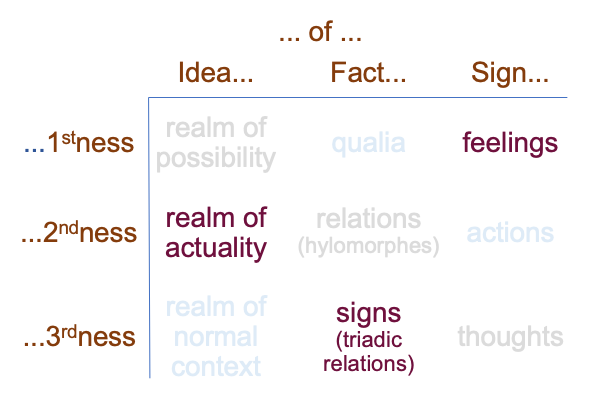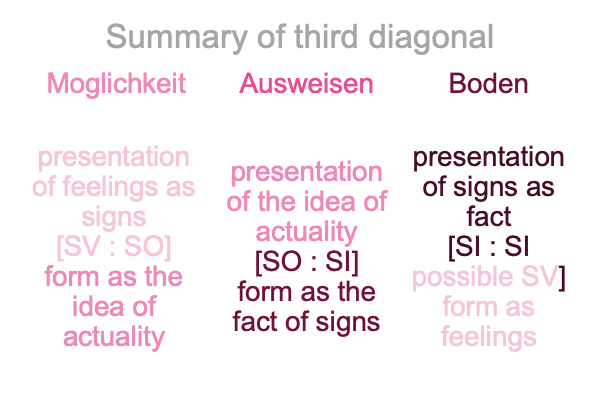0074 One diagonal remains.

Here are the suggested associations.

0075 Sam knocks on the door. He hears a shuffling and the door opens just a bit, “Are you Sam Johnson?”
“Yes”. Sam has a feeling that this book is going to be more interesting than the cover (presentation of feelings as a sign).
The door opens wide and Sam is beckoned to enter by two nerdy fellows. Both wear glasses. Both are around the same age as Sam. The room is full of computers and books and… everything one would expect from a start-up software company. The big room is obviously once the living room of the family who once owned the restaurant below.
The pale one says, “Hi, I am Mel Kandusky. This is Isaac Viruda.”
Isaac is of Indian descent. Not Native American, but southcentral Asian.
Sam says, “Are you any relation to Professor Kandusky, at IIT?”
Mel says, “I’m his son.”
0076 Sam realizes that he is already written into the book (form as the idea of actuality).
Mel continues, “Have a seat. Isaac and I went over the resume that you sent. We have some issues.” Mel looks at Isaac. Isaac smiles, then tries to look serious.
“We think that you may be too earnest for this software startup.”
“What do you mean?”, Sam says, “Your dad told me to apply!” (presentation of the idea of the actuality. The question and comment serves to define the sign-object by raising the fact that this interview is a sign that Professor Kandusky had told Sam about the job).
Isaac starts smiling again.
“Well, we don’t come to work before 11 and we leave right after the restaurant closes at 6. So, we are not working eight hours a day. Plus, we rotate the morning help desk daily, so whoever gets the job will be on call from 7 to 11 while at home for around… “, Mel pretends to count the number of people in the room, “… two days per week. So, we were thinking that may not meet your high standard of earnestness (presentation of the sign of Professor Kandusky’s intrinsic recommendation as fact).”
0077 Sam laughs, and is about to say… when an old woman walks out from the hallway into the former living room. She is obviously a Kandusky.
“Oh, I hope that I’m not interrupting. I’m just passing through. Oh, you are the new…?”
Mel does the introductions, “Sam, this is my grandmother. She owns the restaurant on the first floor. Gramma, this is Sam, he’s going to work with us.”
Mrs. Kandusky says, “Nice to meet you. If you ever want some chicken or fixins, just come downstairs.” (possible sign-vehicle, presentation of feeling as a thing of beauty)
She then proceeds to the door and down the stairs.
0078 So, that is the story of how Sam got a new job.
In terms of Peirce’s formulation of the sign-relation, the feeling that a book is opening (sign-vehicle) stands for the goofy interview (sign-object) in regards to Professor Kandusky’s invitation to Sam to join a family enterprise (sign-interpretant).
In terms of Heidegger’s three features in the grounding of transcendence, Moglichkeit (possibility) is the presentation a feeling inspired by Sam’s grandmother substantiating the idea that the book is actual, Ausweisen (pointing-out) is the presentation of the book of Sam’s resume substantiating the fact that the interview itself is a sign of the Professor’s intention to hire Sam, and Boden (surroundedness) re-presents this sign as an invitation to join the Professor’s family-based team.
0079 Both Peirce’s sign-relation and Heidegger’s grounding of transcendence play into the table of presentative forms,each in a different manner. If Peirce’s and Heidegger’s approaches pertain to a single reality, then I may say that the single reality contains the nine presentative forms in the table.
